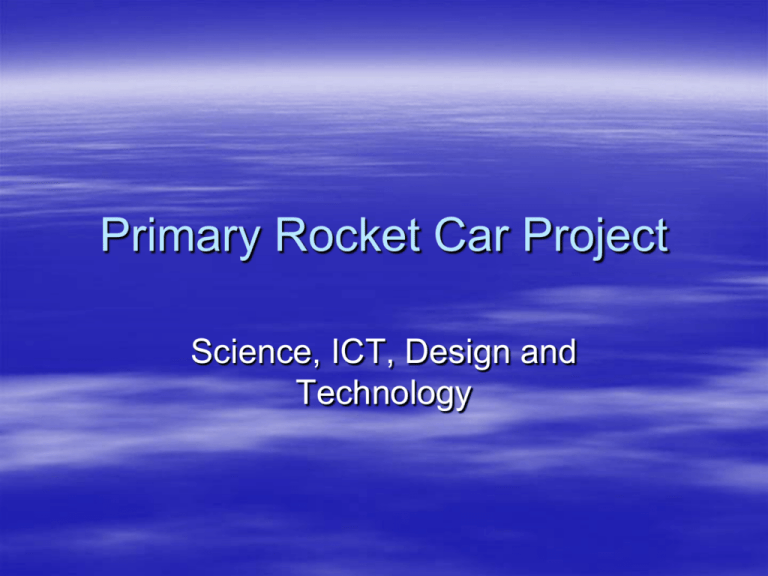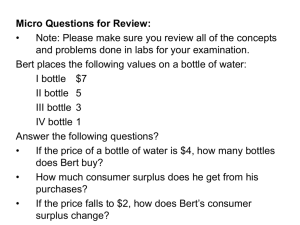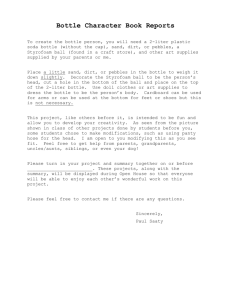Primary Rocket Car Project - Teachnet UK-home
advertisement

Primary Rocket Car Project Science, ICT, Design and Technology The theory This project is designed to bring together children’s skills in science, DT and ICT. It is truly cross curricular and was used with classes of Year 5 and Year 6 children but could be easily adapted for any Key Stage 2 children. Reception children made an excellent audience during the test days! The project makes children think about their knowledge of forces and its application. It is ideal for setting up an exciting fair test with a real purpose and exploring the variables involved. The DT builds on previous skills of making a wheeled chassis and adding the rocket body and there is plenty of scope for thinking about the design in terms of strength and fitness for purpose. Many of our cars were tested to destruction and rebuilt several times! The ICT spreadsheet skills give purpose to the analysis and the presentation of the science results, the graphs illustrate the ease with which the technology is used to present easily understandable results. The other benefits The children work in teams to build their ‘team car’. This generates a massive amount of discussion, social working, collaboration, division of labour and peer teaching of skills. The teams can be given real roles such as director, resource manager, communications officer, mechanic etc. The project was run with groups of 4 children and this number worked well with all children being involved in every stage from design to final presentation. The children also naturally engaged in self assessment and target setting in their enthusiasm to complete the work, often coming back at break times to ensure they were on schedule! What resources are needed Time needed is 6, two hour sessions (approx) Session 1 introduction and design Session 2 build and initial test Session 3 exploratory testing Session 4 accurate fair testing Session 5 spreadsheet construction and data input Session 6 presentation of findings back to the class Alternatively it could feasibly be completed in a themed rocket or forces project week. Construction resources I cm squared softwood 4 Wooden pegs for axle holders Card triangles 4 Wheels Dowel to fit wheels to form axles PVC tubing to slide over dowel A water proof wood glue (available in DIY stores) 2 large cable ties A 2 litre drinks bottle These are suggested materials, your teams may have better ideas for constructing the rolling chassis. Chassis dimensions The children will ideally calculate their own frame size for the 2 litre bottle but if you want to pre-build an example or help less able or younger children these dimensions work well. The frame is held together with card corners and waterproof glue. Wheels can be of any diameter or material as long as they are glued to the dowel axle. Plastic spacers prevent the wheels fouling the chassis or bottle and allow the car to run smoothly. 1.5 cm plastic tubing spacer 18cm 6cm 13cm axle Rocket Body The body is simply an empty 2 litre drinks bottle fixed to the chassis. We used large cable ties for ease of fitting and strength. Completed rolling chassis Chassis with body attached Propulsion We used the connections from a “ROKIT” kit (£6.89) available from good toy shops or TTS (www.tts-group.co.uk) -search for rokit. The bottle is part filled with water, the bung fitted to the mouth of the bottle, the tube from the bung attached to a bicycle pump (track pumps work best and there is usually one in the PE cupboard that you can borrow!). Pump air into the bottle until the pressure is too great for the bung, the bung is forced out and the car will be rapidly propelled forward leaving a watery trail behind it! Click movie to view it again. Testing Cars need to be tested outside due to the expulsion of the water. Children have endless enthusiasm for testing but not necessarily scientifically. We had a play session before the accurate testing. The only extra equipment needed is a start line and a very long tape measure to record the distances travelled. Containers for water, and a 2 litre measuring cylinder for accurate measuring of volumes and a funnel for filling the bottles. It is the air/water combination which is being tested everything else MUST be constant:Volume of water Volume of air (ml) (ml) bottle size, wheel type, surface, slope of surface etc. 2000 0 Children need to discuss the combinations possible, 250 we opted for 250ml increments, which gives each group 9 1750 1500 500 tests to complete, 27 if 3 repeated readings are taken! 1250 750 The play session can be used to narrow this down and 1000 1000 give the children a good idea of the combinations that 750 1250 provide greatest propulsion. 500 1500 ( Which is bottle being ½ to ¾ full of water) 250 1750 0 2000 Results Distance traveled (m) The results can be recorded in an Excel spreadsheet which the children can design themselves or use the one provided (it is pre-populated with genuine test data to give an idea of expected results). More able/older children will be able to use the Which volume of water propelled the car the chart wizard feature to produce a line graph (XY Scatter and select points joined) or furthest? again the spreadsheet provided will allow children to enter their data and the graph will automatically plot. Data is only entered on the graph when a new cell is selected. 10 The resulting graph is shown below. Click on the graph for the datasheet and change the data to see the graph change. 8 6 4 2 0 0 500 1000 1500 Volume of water (ml) 2000 2500 Conclusion Children present their results and conclusions back to the class this is done with reference to the ICT data table and chart. Are there any changes they would like to make? Was it fair? Were repeat readings taken? Was the DT design and construction robust enough to withstand the forces produced? The use of digital images and video enhance these presentations and a short PowerPoint could also be included. But the question that must be answered is……….What was the water/air ratio which propelled the rocket car the furthest? And……….. WHY? Extensions Children can get carried away with this project and often provide their own questions and this results in spin off experimentation without teacher input. However possible planned extensions/differentiations are: To fine tune the ratios to find out exactly what water/air combination between 1000 and 1250ml gives the greatest force – children use 50ml (or less) increments and re-plot their tables and graphs. Use one water/air ratio and change another variable -wheel material or diameter, test track surface etc. Use one water/air ratio and change the size or style of the bottle, add spoilers to increase aerodynamics does it make any difference? Keep an experimental diary containing sketches and photographs, thoughts and hopes, the highs and lows, the modifications and difficulties, the feeling of the team are they working well together? Support material NASA website – loads of rocket based activities and teachers guides (http://exploration.grc.nasa.g ov/education/rocket/TRCR ocket/RocketActivitiesHom e2.html) Instructions on building a balloon rocket car, a good weekend homework task for all the family! (http://www.life.uiuc.edu/boas t1/sciencelessons/rocketca r.htm) Movie 1 Movie 2







